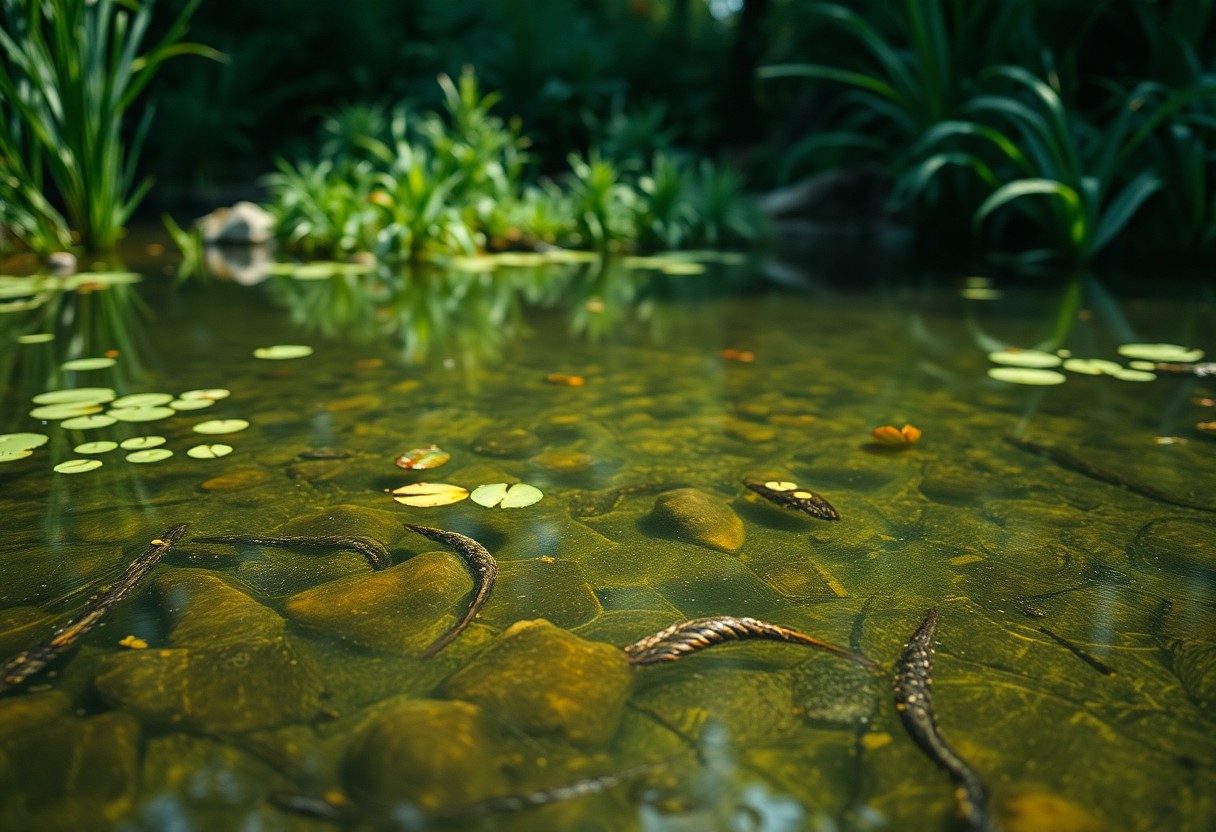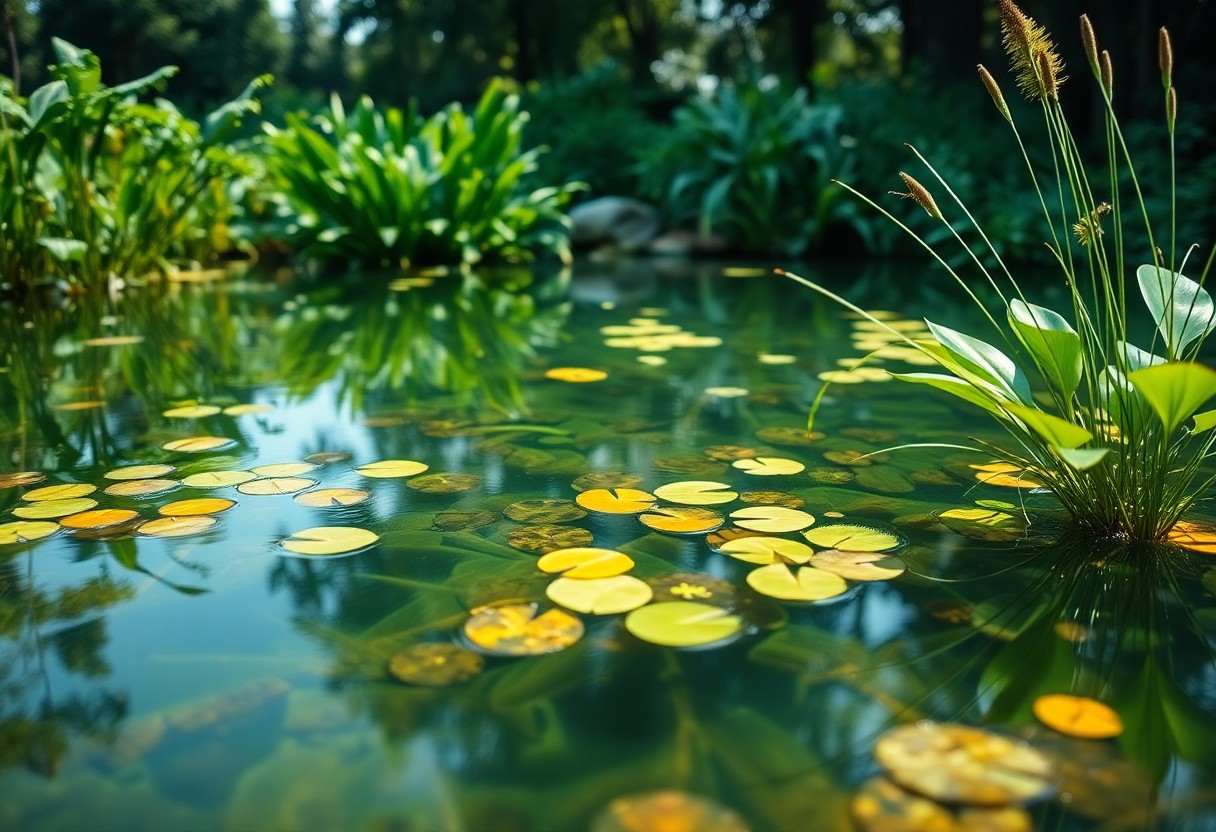You can effectively manage pond algae while promoting a healthy ecosystem using natural methods. By implementing these techniques, you not only enhance the aesthetic appeal of your pond but also safeguard water quality and aquatic life. This guide will walk you through various approaches such as introducing beneficial plants, maintaining proper nutrient levels, and adopting biological control methods to ensure your pond remains clear and vibrant. Say goodbye to harmful chemical treatments and embrace these sustainable solutions for a thriving pond environment.
Table of Contents
Key Takeaways:
- Maintaining a balanced ecosystem through the introduction of beneficial plants and animals can help inhibit algae growth.
- Regularly removing organic debris and excess nutrients from the pond will reduce the food supply for algae.
- Utilizing natural algae-eating species such as certain fish or snails can effectively keep algae populations in check.
- Implementing biological treatments, such as adding beneficial bacteria and enzymes, can promote a healthier pond environment.
- Controlling sunlight exposure with shade from aquatic plants or floating covers can limit algae growth by reducing photosynthesis.
Understanding Pond Algae
While pond algae are a natural part of aquatic ecosystems, they can rapidly overgrow and disrupt the balance within your pond. This growth often occurs due to various environmental factors, leading to aesthetic issues and potentially harming aquatic life. Being aware of the types and causes of algae blooms is necessary for effective management and ensuring a healthy ecosystem in your pond.
Types of Common Pond Algae
One way to manage algae in your pond is by identifying the different types present. Below are some common types of algae:
| Green Algae | Often forms a green film on the water surface |
| Blue-Green Algae | Can produce toxins harmful to aquatic life |
| Filamentous Algae | Grows in long strands, creating a thick mat |
| Chara | A type of algae resembling a plant, often welcomed |
| Detritus | Decayed organic matter, contributing to nutrient buildup |
Thou must learn to identify these algae types to effectively manage their growth.
Factors Contributing to Algae Growth
Types of issues that contribute to algae growth include:
- Excess Nutrients – from fertilizers or decaying plant matter
- Warm Temperatures – favor algae proliferation
- Lack of Water Circulation – stagnant water leads to increased nutrients
- Sunlight Exposure – more light accelerates algae growth
- Improper Pond Care – neglecting cleaning and maintenance
This understanding allows you to implement better management strategies.
Another common factor in algae growth is the introduction of nutrients into the pond, which can come from runoff, overfeeding fish, or dead organic matter. These excess nutrients provide the perfect conditions for algae to thrive, disrupting the ecosystem balance. Implementing practices such as reducing fertilizer runoff and removing decaying plant material can significantly improve your pond’s health and reduce algae blooms. This knowledge empowers you to take control of your pond environment.
Natural Prevention Methods
Assuming you want to keep your pond free from pesky algae, it’s imperative to adopt natural prevention methods. These techniques focus on creating a balanced ecosystem that encourages healthy plant life while discouraging excessive algae growth. By implementing simple strategies, you can maintain a cleaner, more vibrant water body that supports wildlife and enhances your outdoor space.
Proper Pond Design and Depth
Methods for effective pond design include ensuring sufficient depth to support aquatic life and limit sunlight penetration, vital for reducing algae growth. Creating shelves with varying depths allows for diverse plant species, which can outcompete algae for nutrients and light.
Maintaining Water Flow and Aeration
Methods for maintaining water flow and aeration are important in preventing algae buildup. Effective circulation can be achieved through the use of water pumps or natural inflows from streams. Oxygen-rich water helps support beneficial bacteria that break down organic matter, decreasing algae growth. Ensuring your pond has adequate aeration not only keeps the water fresh but also serves as a barrier against harmful toxins that can thrive in stagnant conditions. By regularly monitoring and adjusting your water flow, you encourage a healthier ecosystem overall.
Biological Control Solutions
All natural methods for controlling pond algae focus on biological solutions, which promote a balanced ecosystem. By using techniques such as introducing beneficial organisms, you can help reduce algae growth in your pond. For more insights, check out this Algae control in man-made ponds (non-aerated) discussion.
Beneficial Aquatic Plants
For a healthier pond, consider introducing beneficial aquatic plants. These plants can outcompete algae for nutrients and sunlight, helping to maintain a balanced environment. Not only do they enhance your pond’s aesthetic, but they also provide habitats for various aquatic life, contributing to the overall ecosystem.
Fish and Other Aquatic Animals
Aquatic animals such as fish and snails play an imperative role in controlling algae. Incorporating species that feed on algae, like goldfish or grass carp, effectively reduces excess algae growth. Additionally, snails can help by grazing on algae and detritus, ensuring a cleaner habitat.
Beneficial organisms, when introduced into your pond, can significantly minimize algae levels. For instance, grass carp may consume vast amounts of algae, while fish like koi can help maintain clarity in the water. Always keep in mind, though, that introducing the wrong species can also lead to overpopulation or disruption of the ecosystem. Therefore, thorough research is important when selecting aquatic animals for your pond.
Water Quality Management
Once again, maintaining water quality is imperative in controlling pond algae. Regularly test your water parameters to ensure optimal conditions for your aquatic ecosystem. Monitoring factors such as nutrients, pH levels, and temperature can prevent algae overgrowth and promote a balanced environment for fish and plants.
Nutrient Balance Tips
If you want to achieve a healthy nutrient balance, consider the following tips:
- Limit nutrient runoff by creating buffer zones.
- Avoid overfeeding your fish to minimize organic waste.
- Incorporate aquatic plants to naturally absorb excess nutrients.
After implementing these strategies, you’ll notice a significantly improved ecosystem in your pond.
pH Level Monitoring
Balance your pond’s pH levels to ensure a thriving environment for aquatic life. Aim for a pH between 6.5 and 8.5, as excessive fluctuations can stress fish and promote algae growth. Regular testing allows you to make timely adjustments and maintain optimal conditions.
Another aspect to consider is that a stable pH level not only supports aquatic organisms but also mitigates algae blooms. Use test kits to identify any significant deviations. If your pH is too low or too high, consider using natural methods like adding lime to raise it or organic matter to lower it. Continually monitoring and maintaining pH levels are vital to fostering a balanced aquatic ecosystem and limiting harmful algae’s impact.
Physical Control Methods
Unlike chemical solutions, physical control methods for pond algae utilize natural strategies to manage growth. You can explore Lake and Pond Algae Control and Prevention Services that focus on sustainable practices, allowing you to maintain a healthier ecosystem in your pond.
Manual Removal Techniques
Now you can take an active role in controlling algae by manually removing it from your pond. Using tools like rakes, nets, or skimmers, you can physically extract algal blooms, promoting better water circulation and light penetration which help your pond thrive.
Natural Filtration Systems
Filtration systems using natural elements can effectively maintain water quality and minimize algae growth. By integrating aquatic plants and beneficial bacteria, you encourage a balanced ecosystem that naturally filters excess nutrients, preventing algae blooms.
The integration of natural filtration systems, such as biofilters or constructed wetlands, can significantly enhance the health of your pond. These systems utilize a combination of plants, natural bacteria, and microorganisms to break down organic matter and absorb excess nutrients, ensuring that your water remains clear and free from algae. Moreover, maintaining a balanced ecosystem allows you to enjoy a picturesque pond while reducing dependency on chemical interventions.

Seasonal Maintenance Tips
Your pond’s health greatly depends on your seasonal maintenance practices. To effectively manage pond algae growth, consider the following tips:
- Monitor water temperature and quality
- Remove debris and leaf litter regularly
- Encourage beneficial plants to grow
- Limit fertilizer runoff into the pond
After implementing these strategies, you’ll maintain a balanced ecosystem conducive to preventing algae blooms.
Spring and Summer Care
There’s no better time to actively monitor your pond than during the spring and summer months. Consider adding natural aeration methods to boost oxygen levels, as healthy bacteria help outcompete algae for nutrients. Regularly check for plant overgrowth, and control it to prevent shade issues.
Fall and Winter Preparation
Maintenance before winter is important to your pond’s health come spring. You should clear leaves and debris, which can decompose under ice, releasing nutrients that fuel algae in warmer months.
Summer’s end brings about the need for careful preparation. As temperatures drop, it’s important to remove any accumulated organic matter, ensuring your pond’s ecosystem remains stable. Investing efforts into clearing the pond enhances water clarity and texture. Additionally, maintaining a healthy balance of beneficial bacteria can prevent disturbingly high nutrient levels that encourage algae growth during warmer days ahead.
To wrap up
On the whole, managing pond algae naturally involves a combination of strategies that promote a balanced ecosystem. You can enhance your pond’s health by introducing beneficial plants, controlling nutrient levels, and maintaining proper aeration. Regular monitoring and maintenance will help you prevent overgrowth, allowing your pond to thrive without harming the aquatic life within it. By taking these steps, you can enjoy a clear and vibrant pond environment that benefits both you and the local ecosystem.
FAQ
Q: What are some effective natural methods for controlling pond algae?
A: There are several natural methods to manage pond algae, including introducing beneficial bacteria that outcompete algae for nutrients, using aquatic plants to absorb excess nutrients, and adding barley straw or pond dye to inhibit algae growth by blocking sunlight. Regularly maintaining a balanced ecosystem is key to preventing algae blooms.
Q: How do aquatic plants help in controlling pond algae?
A: Aquatic plants, such as water lilies and hornwort, can absorb excess nutrients like nitrogen and phosphorus from the water, which are the main contributors to algae growth. By using these plants, you create competition for resources, thus limiting the available nutrients for algae to thrive.
Q: Can adding fish help with algae control in my pond?
A: Yes, certain fish species can help control algae. For instance, grass carp are known to consume aquatic vegetation, including algae. Additionally, having fish like koi can stir up sediment and promote a healthy ecological balance, which can indirectly reduce algae levels. However, introducing fish should be done cautiously, considering their impact on the overall ecosystem.
Q: Is using barley straw effective for algae control?
A: Yes, barley straw is a natural method for managing algae. When barley straw decomposes in water, it releases compounds that can inhibit the growth of algae. It’s often placed in mesh bags and submerged in the pond, but it can take some time (several weeks) to see results, so consistency is necessary.
Q: What should I avoid when trying to control algae naturally?
A: When attempting to control pond algae naturally, it’s best to avoid using chemical algaecides or fertilizers, as these can upset the ecological balance and lead to more problems. It’s also important to avoid overstocking fish and introducing non-native species that may disrupt the ecosystem. Maintaining good pond hygiene and balance is crucial.

